Articles
- Page Path
- HOME > J Korean Acad Nurs > Volume 38(2); 2008 > Article
-
Original Article
- The Development and Effects of an Integrated Symptom Management Program for Prevention of Recurrent Cardiac Events after Percutaneous Coronary Intervention
- Youn-Jung Son
-
Journal of Korean Academy of Nursing 2008;38(2):217-228.
DOI: https://doi.org/10.4040/jkan.2008.38.2.217
Published online: April 30, 2008
Assistant Professor, Department of Nursing, Soonchunhyang University, Cheonan, Korea.
- Address reprint requests to: Son, Youn-Jung. Department of Nursing, College of Medicine, Soonchunhyang University, 366-1 Ssangyong-dong, Cheonan 330-090, Korea. Tel: 82-41-570-2487, Fax: 82-41-575-9347, yjson@sch.ac.kr
Copyright © 2008 Korean Society of Nursing Science
Abstract
-
Purpose
- This study was conducted to develop and to determine the effects of an integrated symptom management program for prevention of recurrent cardiac events after percutaneous coronary intervention.
-
Methods
- Subjects consisted of 58 CAD patients (experimental group: 30, control group: 28). The experimental group participated in an integrated symptom management program for 6 months which was composed of tailored education, stress management, exercise, diet, deep breathing, music therapy, periodical telephone monitoring and a daily log. The control group received the usual care.
-
Results
- The experimental group significantly decreased symptom experiences and the level of LDL compared to the control group. The experimental group significantly increased self care activity and quality of life compared to the control group. Although no significant difference was found in cardiac recurrence, the experimental group had fewer recurrences.
-
Conclusion
- These results suggest that an integrated symptom management program for prevention of recurrent cardiac events after percutaneous coronary intervention can improve symptom aggravation, recurrent rate, self care activity and quality of life. Nursing interventions are needed to maintain and further enhance the quality of life of these patients and the interventions should be implemented in the overall transition period.
This work was supported by the Korea Research Foundation Grant funded by the Korean Goverment (MOEHRD) KRF-2005-003-E00293
- 1. Appels A, Bär F, Lasker J, Flamm U, Kop W. The Effect of a psychological intervention program on the risk of a new coronary event after angioplasty: a feasibility study. Journal of Psychosomatic Research. 1997;43:209–217.ArticlePubMed
- 2. Barnason S, Zimmerman L, Nieveen J, Schmaderer M, Carranza B, Reilly S. Impact of a home communication intervention for coronary artery bypass graft patients with ischemic heart failure on self efficacy, coronary disease risk factor modification, and functioning. . Heart&Lung. 2003;32:147–158.Article
- 3. Barnason S, Zimmerman L, Brey B, Catlin S, Nieveen J. Patterns of recovery following percutaneous coronary intervention: a pilot study. Applied Nursing Research. 2006;19:31–37.ArticlePubMed
- 4. Black JM, Matassarin-Jacobs E. Medical-Surgical Nursing. 1997;5th ed. Philadelphia, Saunders Co..
- 5. Bogaty P, Poirier P, Simard S, Boyer L, Solymoss S., Dagenais G. Biological profiles in subjects with recurrent acute coronary events compared subjects with long standing stable angina. Circulation. 2001;103:3062–3068.ArticlePubMed
- 6. Brown SJ, Lieberman DA, Germeny BA, Fan YC, Wilson DA, Pasta DJ. Educational video games for juvenile diabetes: results of a controlled trial. Medical Informatics. 1997;22:77–89.ArticlePubMed
- 7. Cohen J. Statistical power analysis for the behavioral science. 1988;2nd ed. New Jersey, Lawrence Erlbaum Association Pub..
- 8. Dodd M, Janson S, Facion N, Faucett J, Froelicher ES. Advancing the science of symptom management. Journal of Advanced Nursing. 2001;33:668–676.ArticlePubMed
- 9. Fernandez RS, Griffiths R, Juergens C, Davidson P, Salamonson Y. Persistence of coronary risk factor status in participants 12 to 18 months after percutaneous coronary intervention. The Journal of Cardiovascular Nursing. 2006;21:379–387.ArticlePubMed
- 10. Gulanick M, Blileu A, Perino B, Keough V. Effects of intensive multiple risk factor reduction on coronary atherosclerosis and clinical cardiac events in men and women with CAD. Circulation. 1998;89:975–990.Article
- 11. Hanssen TA, Nordrehaug JE, Eide GE, Hanestad BR. Improving outcomes after myocardial infarction: a randomized controlled trial evaluating effects of a telephone follow up intervention. European Journal of Cardiovascular Prevention and Rehavilitaion. 2007;14:429–437.ArticlePDF
- 12. Kim GY. Development of a critical pathway for patients with coronary artery bypass graft. Journal of Korean Academy of Nursing. 1998;28:117–131.ArticlePDF
- 13. Kim HS, Park MJ. Correlation between knowledge and educational needs related to recurrence in coronary artery bypass graft patients. Journal of Korean Academy of Nursing. 2000;30:549–559.
- 14. Koh SB, Chang SJ, Kang MG, Cha BS, Park JK. Reliability and validity on measurement instrument on health status assessment in occupational workers. Korean Journal of Preventive Medicine. 1997;30:251–266.
- 15. Kop WJ. Acute and chronic psychological risk factors for coronary syndromes: moderating effects of coronary artery disease severity. Journal of Psychosomatic Research. 1997;43:167–181.ArticlePubMed
- 16. 2005 Etiology of mortality in Korea. 2006;Retrieved 2006 Nov 10. Korea National Statistical Office. from http://www.nso.go.kr.
- 17. Lee YW, Kim HS, Cho EY. The influencing factors on health behavior of patients with coronary artery disease. Journal of Korean Academy of Nursing. 2002;32:40–49.ArticlePDF
- 18. Lerakis S, El-chami MF, Patel AD, Veledar E, Alexopoulos E, Zacharoulis A, et al. Effects of lipid levels and lipid lowering therapy on restenosis after coronary artery stenting. The American Journal of Medical Sciences. 2006;331:270–273.
- 19. Lichtman JH, Amatruda J, Yarri S, Cheng S, Smith GL, Mattera JA, et al. Clinical trial of an educational intervention to achieve recommended cholesterol levels in patients with coronary artery disease. American Heart Journal. 2004;147:522–528.ArticlePubMed
- 20. Odell A, Grip L, Hallberg LR. Restenosis after percutaneous coronary intervention: experiences from the patient's perspective. European Journal of Cardiovascular Nursing. 2006;5:150–157.ArticlePubMedPDF
- 21. Park JA. The comparative study on stress and the compliance of sick role behavior according to the restenosis of coronary artery intervention patient. 2003;Seoul, Kyunghee University. Unpublished master's thesis.
- 22. Sinclair AJ, Conroy SP, Davies M, Bayer AJ. Post discharge home based support for older cardiac patients: a randomized controlled trial. Age and Ageing. 2005;34:338–343.PubMed
- 23. Slavin L, Chhabra A, Tobis JM. Drug-eluting stents: preventing restenosis. Cardiology in Review. 2007;15:1–12.PubMed
- 24. Taylor CB, Miller NH. Wenger NK, Hellerstein HK. Rehabilitation of coronary patient. In: Education of the coronary patient and family: the behavioral approach. 1991;3rd ed.New York, Churchill Livingstone.
- 25. Ware JE, Sherboune CD. The Mos 36-item short form health survey (SF-36). Medical Care. 1992;30:473–483.ArticlePubMed
- 26. Wong MS, Chair SY. Changes in health related quality of life following percutaneous coronary intervention: a longitudinal study. Internaltional Journal of Nursing Studies. 2007;44:1334–1342.Article
- 27. Zimmerman L, Barnason S, Schulz P, Nieveen J, Miller C, Hertzog M, et al. The effects of a symptom management intervention on symptom evaluation, physical functioning, and physical activity for woman after coronary artery bypass surgery. Journal of Cardiovascular Nursing. 2007;22:493–500.PubMed
REFERENCES
Figure & Data
REFERENCES
Citations

- Exercise-based cardiac rehabilitation for coronary heart disease
Grace Dibben, James Faulkner, Neil Oldridge, Karen Rees, David R Thompson, Ann-Dorthe Zwisler, Rod S Taylor
Cochrane Database of Systematic Reviews.2021;[Epub] CrossRef - Effects of Video Program by Tablet PC on Anxiety, Vital Signs, Pain, and Knowledge Level among Patients Undergoing Percutaneous Coronary Intervention
Hyun Hee Park, Gye Seon Jeong
Korean Journal of Adult Nursing.2021; 33(2): 102. CrossRef - Development and Assessment of a Social Network Service-Based Lifestyle-Modification Program for Workers at High Risk of Developing Cardiovascular Disease
Soo Hee Woo, Eui Geum Oh, Kyung-SOO Kim, Sang Hui Chu, Gwang Suk Kim, Chung Mo Nam
Workplace Health & Safety.2020; 68(3): 109. CrossRef - Effect of Cardiopulmonary Physiotherapy on Patients With Percutaneous Coronary Intervention - Systematic Review and Meta-Analysis
Na-yoon Kang, Beom-seok Park, Min-hee Kim
Journal of The Korean Society of Physical Medicine.2019; 14(1): 63. CrossRef - Moderating effect of Lifestyle and Type D personality on the Relationship between Metabolic Syndrome and Severity of Coronary Artery Disease
In-Kyoung Noh, Myoung Soo Kim
Korean Journal of Adult Nursing.2018; 30(3): 290. CrossRef - Development and Effectiveness of Tailored Education and Counseling Program for Patients with Coronary Artery Disease undergoing Percutaneous Coronary Intervention
So-Yeon Kim, Min Young Kim
Korean Journal of Adult Nursing.2017; 29(5): 547. CrossRef - Long-term effects of nurse-led individualized education on middle-aged patients with acute coronary synrome: a quasi-experimental study
Jae Lan Shim, Seon Young Hwang
BMC Nursing.2017;[Epub] CrossRef - Comparison of Health Behavior Change Before and After the Percutaneous Coronary Intervention among Coronary Artery Disease Patients
Jung-Hun Lee, Kyeong-Soo Lee, Tae-Yoon Hwang
Journal of agricultural medicine and community health.2016; 41(3): 140. CrossRef - Exercise-based cardiac rehabilitation for coronary heart disease
Lindsey Anderson, David R Thompson, Neil Oldridge, Ann-Dorthe Zwisler, Karen Rees, Nicole Martin, Rod S Taylor
Cochrane Database of Systematic Reviews.2016;[Epub] CrossRef - Health-related Quality of Life in Symptomatic Postmyocardial Infarction Patients with Left Ventricular Dysfunction
Ha Mi Kim, JinShil Kim, Seon Young Hwang
Asian Nursing Research.2015; 9(1): 47. CrossRef - Risk Factor–tailored Small Group Education for Patients with First-time Acute Coronary Syndrome
Seon Young Hwang, Jin Shil Kim
Asian Nursing Research.2015; 9(4): 291. CrossRef - Development and Evaluation of a Self Care Education Program for Elderly Patients with Percutaneous Coronary Intervention
Gyeong-Jin Jo, Jin-Hyang Yang
The Journal of Korean Academic Society of Nursing Education.2014; 20(2): 266. CrossRef - Development of Smartphone Educational Application for Patients with Coronary Artery Disease
Min Jung Cho, Jae Lan Sim, Seon Young Hwang
Healthcare Informatics Research.2014; 20(2): 117. CrossRef - The Health Behavioral Experience of Patients with Myocardial Infarction during the Recovery Period
Kyung Ja Kang, Moon Jeong Kim
Korean Journal of Adult Nursing.2014; 26(2): 203. CrossRef - Effects of a psychoeducational intervention for secondary prevention in Korean patients with coronary artery disease: A pilot study
Jin‐Hee Park, Seung‐Jae Tahk, Sun Hyoung Bae, Youn‐Jung Son
International Journal of Nursing Practice.2013; 19(3): 295. CrossRef - Comparison of Cardiovascular Health Status and Health Behaviors in Korean Women based on Household Income
Young-Joo Park, Nah-Mee Shin, Ji-Won Yoon, Jiwon Choi, Sook-Ja Lee
Journal of Korean Academy of Nursing.2010; 40(6): 831. CrossRef
- Figure
- We recommend
- Related articles
-
- Development and Evaluation of an App-Based Self-Management Program for Exercise Practice of Breast Cancer Survivors: A Non-Randomized Controlled Trial
- Effects of Non-Pharmacological Interventions on Major Adverse Cardiac Events in Patients Underwent Percutaneous Coronary Intervention: Systematic Review and Meta-Analysis
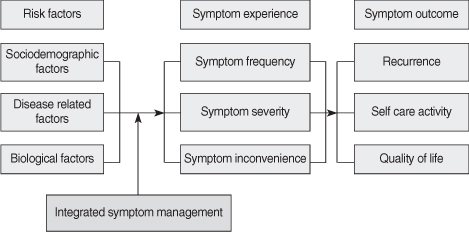

Figure 1
Figure 2
Integrated Symptom Management Program
Homogeneity Test of Sociodemographic and Disease related Characteristics between Two Groups
ACS=Acute coronary syndrome; BMI=Body mass index; DB=Diabetes mellitus; PCI=Percutaneous coronary intervention; PTCA=Percutaneous transluminal coronary angioplasty.
Homogeneity Test of Dependent Variables between Two Groups before the Intervention
HDL=High density lipoprotein; LDL=Low density lipoprotein.
Differences of Cardiac Recurrence after the Intervention
Effects of Integrated Symptom Management on Dependent Variables
*p<0.01. HDL=High density lipoprotein; LDL=Low density lipoprotein.
ACS=Acute coronary syndrome; BMI=Body mass index; DB=Diabetes mellitus; PCI=Percutaneous coronary intervention; PTCA=Percutaneous transluminal coronary angioplasty.
HDL=High density lipoprotein; LDL=Low density lipoprotein.
*p<0.01. HDL=High density lipoprotein; LDL=Low density lipoprotein.
 KSNS
KSNS
 E-SUBMISSION
E-SUBMISSION


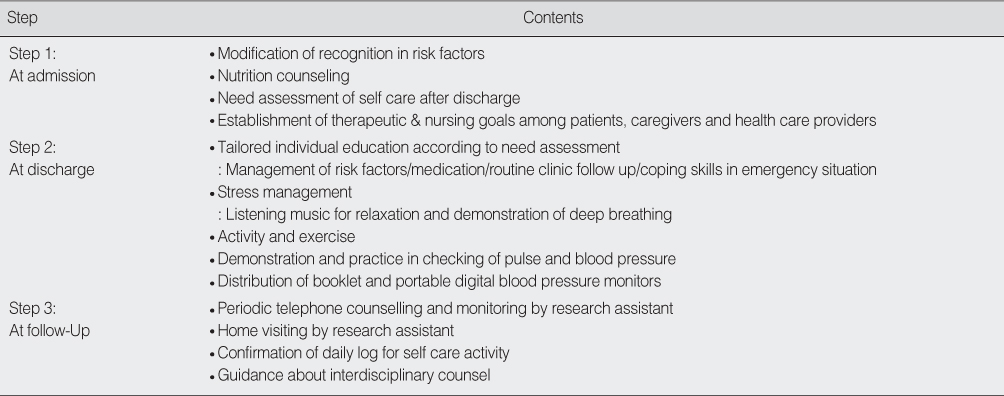
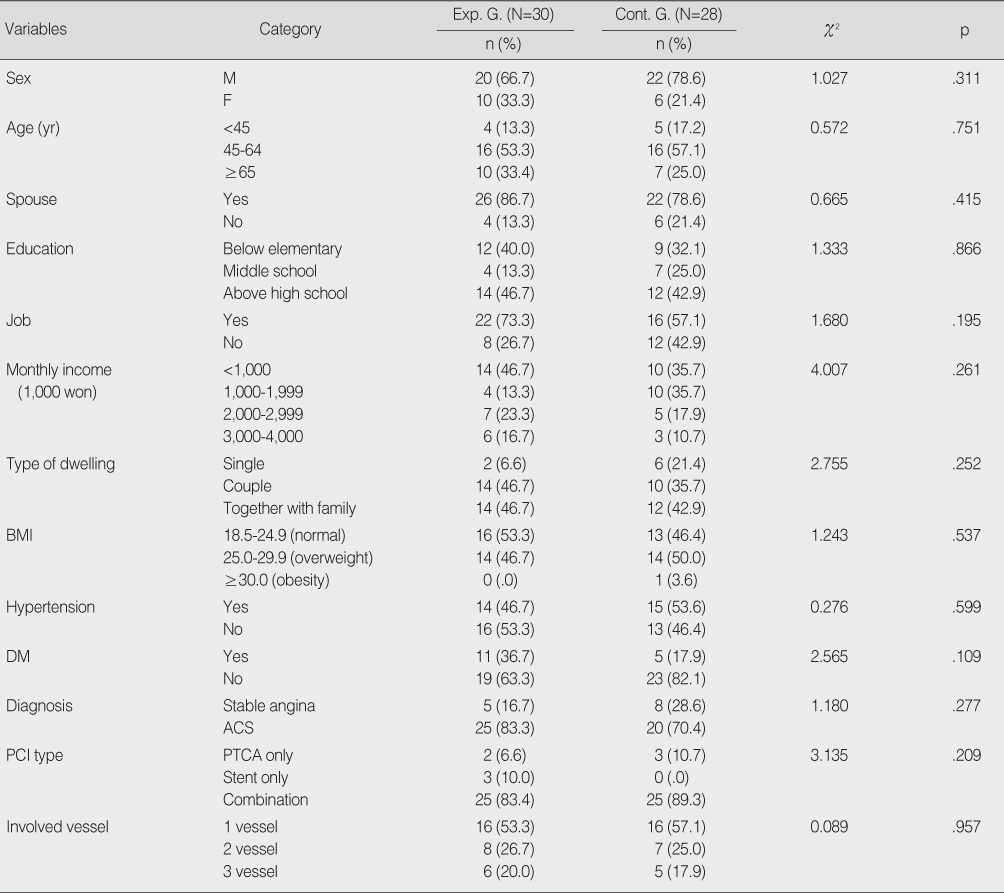
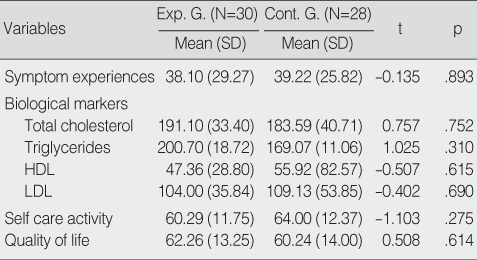

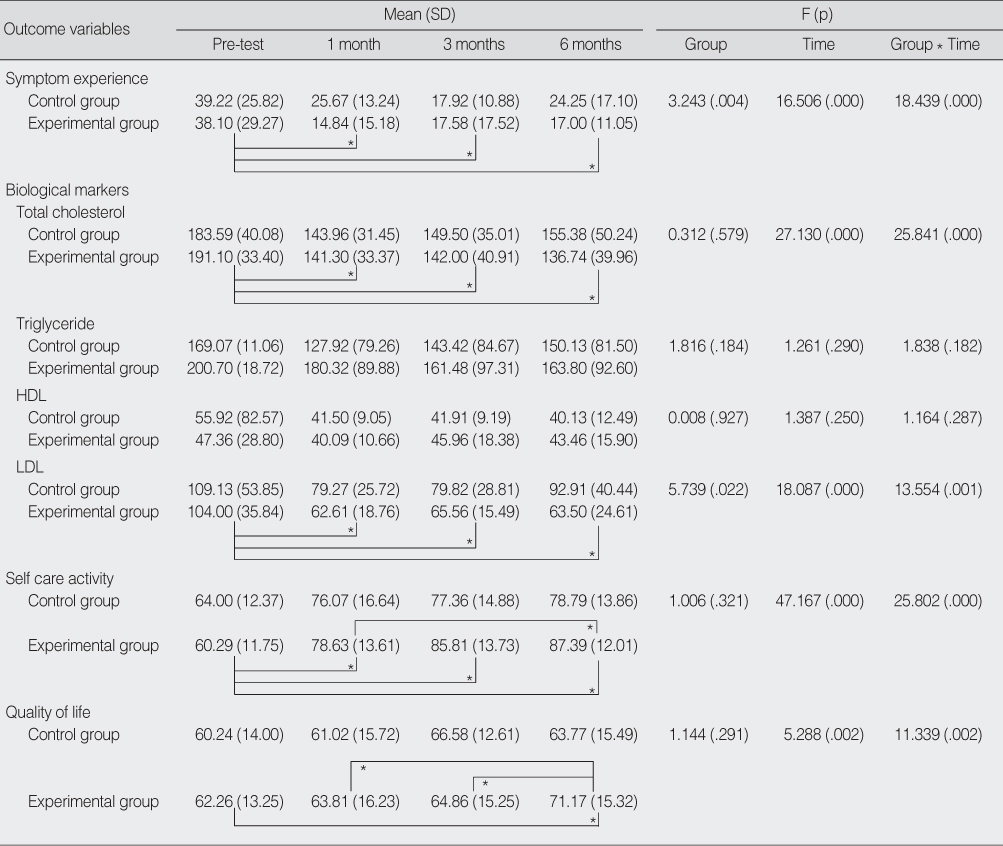
 Cite
Cite

